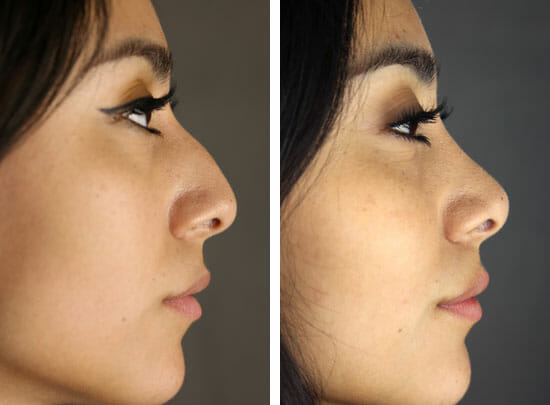



Rhinoplasty 15
The patient is a 26 year old woman who felt that her nose was too large for her face and that it was too thick looking. She also noted the “bump” and thought if that was taken down she might look better. She had a closed rhinoplasty which was performed safely and comfortably under general anesthesia. There was no pain after her surgery and rhinoplasty recovery is minimal, in terms of what one must do. She was seen the next day and her splint was removed six days after her procedure. At that point she was able to see that the “bump” was gone and she was very happy. Swelling in the tip of the nose took about three to six months to come down and by that point she noted that she could see the sculpting points that made her tip look beautiful. She was also happy that her nose was smaller and that it matched her face.
What is Rhinoplasty?
Rhinoplasty surgery is a procedure where the appearance of the nose is altered to gain beauty within the nose itself and also to match the nose to the face to create harmony. Often, patients say in their consultation with their facial plastic surgeon that they feel their nose is “stealing the show” and “taking over their face”, often because the nose is too large and detracting from the other beautiful parts of their face. So in a way, most rhinoplasties are “reduction rhinoplasties” where the nose is made smaller to match the smaller facial features and the smaller dimensions of the face.
It’s About the Structure
Rhinoplasty technique is directed to the structure of the nose and not the skin. The structural parts are the bone and cartilage that support the skin. These firm structures are changed and the skin falls over the new structure to create the beautiful results of the rhinoplasty. The nasal bones are often prominent and along with cartilage create a prominence in the center of the nose that some patients refer to as the “bump”. During rhinoplasty, this bump is taken down and smoothed out to create a straight line from the upper part of the nose to the tip. This straight and gliding line defines the nose by removing the bump which had two lines in it to one straight line. Plastic surgeons have recognized that this line should gently come up into the tip, with the tip being the part of the nose that sticks out the most as compared to the other parts of the nose, like the bump or the area just above the tip.
The Nasal Tip
Patients who come for rhinoplasty almost always think that their nasal tip is either too large or too wide and plastic surgeons often refer to this as a “bulbous tip”. The bulbous tip is too wide and too high and because of its boxy shape is taking beauty and harmony away from the nose. Just as with treatment of the “bump”, cartilage is treated to make it smaller, weaker and even to change the shape to decrease the prominence and boxy shape of the tip itself.
Closed and Open Rhinoplasty
Most patients have tips that are overly projecting (stick out too much) and are too large for their nose and for these patients, a closed rhinoplasty can suffice. Closed rhinoplasty is performed entirely from the inside of the nose and so there are no scars on the outside. And because there are no scars and because there is minimal energy applied to the tissues in this beautiful surgery, the selling goes down quickly. Open rhinoplasty is generally performed when the tip is deficient (doesn’t stick out enough) and advancing the tip cartilage forward or adding cartilage is required. Since open rhinoplasty requires incisions outside the nose and because the surgery takes longer and the tissues are moved more, swelling can take a long time to go down and it takes longer to see the results of the procedure. There are many other reasons why a patient might have an open rhinoplasty including the training of the plastic surgeon and the aesthetic goals of the patient in consultation with the rhinoplasty surgeon.
The Beautiful Elements
Rhinoplasty surgery itself is carried out in a beautiful and orderly cascade of very few movements. Each movement has a specific goal or effect. In fact, and amazingly, one maneuver may have several effects and so it is the focus of the plastic surgeon who loves rhinoplasty to make sure that the wished effects of a maneuver are expressed in the result of the action. It is the blending of these different effects that make the surgery itself beautiful.
The Beautiful Mystery
That plastic surgery creates beauty can be seen from these and other rhinoplasty before and after photos. But exactly how the beauty results from rhinoplasty remains a mystery. Perhaps that is because we all define what we feel is beautiful. But no matter how we plan, analyze or use computer generated photos to determine what the nose will look like, we can have a general idea but we simply cannot know exactly how the rhinoplasty has caused beauty nor how it will make the face more aesthetically appealing. The proof of this is that this patient’s new nasal anatomy has made her face look better and there is no all encompassing explanation for how this has happened. We might say that the nose itself is more proportional or that we have diminished the size of the nose in order that one can see the other beautiful parts of the face. We might hypothesize that the nose is thinner and more feminine or even more proportionate to the face as per our doing. All of these goals are part of the process of rhinoplasty surgery. Plastic surgery is ultimately an art and perhaps rhinoplasty, a plastic surgeon’s greatest achievement.
